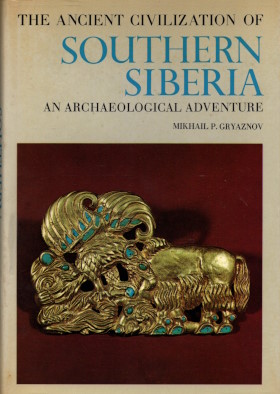 Mikhail P. Gryaznov
Mikhail P. Gryaznov
The Ancient Civilization of Southern Siberia,
an archaeological adventure.
// N.Y.: Cowles Book Co. 1969. 252 p. (Ancient civilizations)
Contents
Introduction. Ч 9
The Country and the People. Ч 9
The Archaeological Discovery of Southern Siberia. Ч 14
Problems, Methods, Controversies. Ч 24
Chapter I. The Eneolithic Period. Ч 45
The Afanasyevskaya Culture (End of Third Millennium B.C.). Ч 46
The Okunev Culture (Beginning of Second Millennium B.C.). Ч 51
Chapter II. The Bronze Age. Ч 67
The Andronovo Culture (Middle of Second Millennium B.C.). Ч 89
The Karasuk Culture (13th to 8th Centuries B.C.). Ч 97
Chapter III. The Age of the Early Nomads. Ч 131
The Nomads of the Altay. Ч 134
Settlements in the: Ob Valley. Ч 199
The Tagar Culture. Ч 213
The Peoples of Tuva. Ч 219
Chronological Table. Ч 237
List of Illustrations [1-170]. Ч 239
Index. Ч 249
Conclusion. ^
We do not know when a population of Europoid type first appeared in Southern Siberia; nor do we know where it came from. Archaeological evidence tells us the history of the Europoid peoples of Siberia only from the beginning of the Neolithic period, when they started to use metal for the manufacture of implements, to rear domestic animals and to cultivate useful plants, and thus set out on the process of development towards a productive economy.
Southern Siberia was on the eastern periphery of the area settled by the Europoid peoples; and in this region we can trace their history over a period of more than two thousand years down to the age of the early nomads, when the nomadic stock-rearing economy, which we now regard as wasteful and outdated, was in the circumstances of the time a progressive system which made possible an unprecedented advance in the economic prosperity of the stock-farming peoples of the steppes. This economic progress was accompanied by a general rise in the level of culture and by a high standard of artistic production. This was the heroic period in the history of the ancient peoples of Siberia, the period which gave birth to the great heroes of popular tradition and produced talented practitioners of folk art. It was also a period of cruel and barbarous warfare and of incessant looting and plunder.
And yet it was the last period of relatively peaceful and relatively stable existence for the peoples of Eurasia. At the beginning of our era, with the start of the great migrations, the whole steppe region was thrown into turmoil. In Southern Siberia too there was a change of population, when the Europoid peoples were replaced Ч no doubt partly by massacre, partly by expulsion, and partly by absorption and assimilation Ч by the Mongoloid peoples who now pressed in from Central Asia.
наверх
|